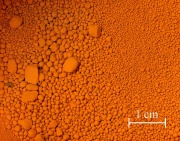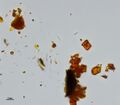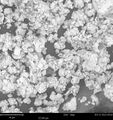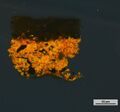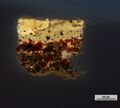Difference between revisions of "Chrome red"
(added cross-sections) |
|||
| (3 intermediate revisions by 2 users not shown) | |||
| Line 2: | Line 2: | ||
== Description == | == Description == | ||
| − | A basic lead chromate pigment that ranges in shades from orange to red. First made in 1809 by Vauquelin, basic lead chromate is formed by heating [[lead chromate]] and [[sodium hydroxide]] solution. The color of chrome red or chrome orange can vary from a brown-yellow to a brick-red color depending on particle size and to the ratio of lead oxide to lead chromate. It is stable in light but is not widely used because of its sensitivity to sulfur gases. Most often, chrome red is used as an anticorrosive base coats for steel. See also [[chrome yellow]]. | + | A basic lead chromate pigment that ranges in shades from orange to red. First made in 1809 by Vauquelin, basic lead chromate is formed by heating [[lead chromate]] and [[sodium hydroxide]] solution. The color of chrome red or chrome orange can vary from a brown-yellow to a brick-red color depending on particle size and to the ratio of lead oxide to lead chromate. The synthesized version is chemically the same as the mineral [https://www.mindat.org/min-3194.html phoenicochroite]. It is stable in light but is not widely used because of its sensitivity to sulfur gases. Most often, chrome red is used as an anticorrosive base coats for steel. See also [[chrome yellow]]. |
[[File:Lead.chromate.basic_det.jpg|thumb|Chrome red]] | [[File:Lead.chromate.basic_det.jpg|thumb|Chrome red]] | ||
| Line 23: | Line 23: | ||
|- | |- | ||
! scope="row"| Composition | ! scope="row"| Composition | ||
| − | | | + | | Pb2O(CrO4) |
|- | |- | ||
! scope="row"| CAS | ! scope="row"| CAS | ||
| Line 40: | Line 40: | ||
==Additional Images== | ==Additional Images== | ||
<gallery> | <gallery> | ||
| − | + | File:Red pigments2 PPL 1000x.jpg|thumb|Chrome red pigments, PPL, 1000x | |
| − | + | File:Red paint2 PLM1 XPL2 1000x.jpg|thumb|Chrome red pigments, XPL, 1000x | |
| − | + | File:Red pigments1 PPL 1000x.jpg|thumb|Chrome red pigments, PPL, 1000x | |
| − | + | File:SEM overall 1.jpg|thumb|SEM-BSE of chrome red pigment particles | |
| − | + | File:Tabular crystal SEM.jpg|thumb|SEM-BSE image of chrome red tabular pigment particles with EDS data | |
| − | + | File:Sample1a repolished 200x screenshot.jpg|thumb|chrome red paint in cross-section, visible light, 200x | |
| + | File:Sample1a repolished UV 200x screenshot.jpg|thumb|chrome red paint in cross-section, UV light, 200x | ||
</gallery> | </gallery> | ||
Latest revision as of 14:26, 22 September 2022
Description
A basic lead chromate pigment that ranges in shades from orange to red. First made in 1809 by Vauquelin, basic lead chromate is formed by heating Lead chromate and Sodium hydroxide solution. The color of chrome red or chrome orange can vary from a brown-yellow to a brick-red color depending on particle size and to the ratio of lead oxide to lead chromate. The synthesized version is chemically the same as the mineral phoenicochroite. It is stable in light but is not widely used because of its sensitivity to sulfur gases. Most often, chrome red is used as an anticorrosive base coats for steel. See also Chrome yellow.
Synonyms and Related Terms
red lead chromate; Pigment Red 103; CI 77601; Chromrot (Deut.); rouge de chrome (Fr.); rojo de cromo (Esp.); rosso cromo (It.); vermelho de crómio (Port.); chrome orange, Persian red; Austrian red; Derby red; Chinese red; Vienna red; Victoria red; American vermilion; garnet chrome; ruby red chrome; Austrian cinnabar; chrome vermilion
Risks
- Toxic by inhalation or ingestion.
- Skin contact may cause irritation or ulcers.
- Carcinogen, teratogen, suspected mutagen.
- Discolored by heat and sulfur fumes.
Physical and Chemical Properties
Soluble in strong acids and alkalis. Can change to yellow in acetic acid. Insoluble in water. Deep orange-red color in PPL, distinct tabular morphology in many crystals (denotes synthetic form as opposed to mineral source), around 10um in length. Birefringence strongly masked by the body color. Occasional green interference colors, much less marked than would be observed with red lead.
| Composition | Pb2O(CrO4) |
|---|---|
| CAS | 7758-97-6 |
| Density | 6.7 g/ml |
| Molecular Weight | mol. wt. = 323.2 |
| Refractive Index | 2.42; 2.7 |
Additional Images
Resources and Citations
- J. Bersch, (orig. 1893)The Manufacture of Mineral and Lake Pigments: Containing Directions for the Manufacture of All Artificial Artists' and Painters' Colours, Enamel Colours, Soot and Metallic Pigments, 1901 ed. See pp. 186-187.
- H. Kuhn, M.Curran, "Chrome Yellow and Other Chromate Pigments", Artists Pigments, Volume 1, R. Feller (ed.), Cambridge University Press: Cambridge, 1986.
- R. J. Gettens, G.L. Stout, Painting Materials, A Short Encyclopaedia, Dover Publications, New York, 1966 Comment: p. 106
- M. Doerner, The Materials of the Artist, Harcourt, Brace & Co., 1934
- G.S.Brady, Materials Handbook, McGraw-Hill Book Co., New York, 1971 Comment: p. 445
- Ralph Mayer, A Dictionary of Art Terms and Techniques, Harper and Row Publishers, New York, 1969 (also 1945 printing)
- Richard S. Lewis, Hawley's Condensed Chemical Dictionary, Van Nostrand Reinhold, New York, 10th ed., 1993
- Michael McCann, Artist Beware, Watson-Guptill Publications, New York City, 1979
- R.D. Harley, Artists' Pigments c. 1600-1835, Butterworth Scientific, London, 1982
- Dictionary of Building Preservation, Ward Bucher, ed., John Wiley & Sons, Inc., New York City, 1996
- Monona Rossol, The Artist's Complete Health and Safety Guide, Allworth Press, New York, 1994
- Van Nostrand's Scientific Encyclopedia, Douglas M. Considine (ed.), Van Nostrand Reinhold, New York, 1976
- The Merck Index, Martha Windholz (ed.), Merck Research Labs, Rahway NJ, 10th edition, 1983 Comment: entry 5423
- Art and Architecture Thesaurus Online, https://www.getty.edu/research/tools/vocabulary/aat/, J. Paul Getty Trust, Los Angeles, 2000

